Do It Yourself rainwater storage tank.


A week (or two?) ago I post a photo of a rainwater storage tank I made for my partner's desert 'garden'. I promised to get right on an essay about it, for the Resilience series, and then work and other life got in the way. So here it is...a bit late. Maybe Gerrit can help me put a Resiliency header on it.
We actually have two of them...one at the house, one out in the desert. We bought two 175 gallon, galvanized stock tanks, 6 feet long, about 2 feet tall, and two feet wide. Two fit in a pickup truck. The base is made of cinder blocks...we scavenged some from another project. I used five for each base...two at each end, spaced the width of the tank, and one in the center to keep the belly of the tank from sagging. You might have to did a little to level them, I just wiggled them into our sandy soil.

Next comes a full sheet (4'x8') of 3/4" plywood. One sheet was enough to make a platform for the two tanks. I cut them slightly larger than the bottom of the tank, rounding the ends with a sabre saw...our plans called for leaving the ends square, but I didn't want to continually catch my ankles on the corners. Then simply set the plywood on the cinder blocks, making a platform, and then set the tank on top. The tank has a fitting to put in a hose bib, in the middle of one of the long sides. The platform raises the tank up enough to let the water flow out by gravity, through a very simplistic drip system. More height would give more water pressure...our system has very little.
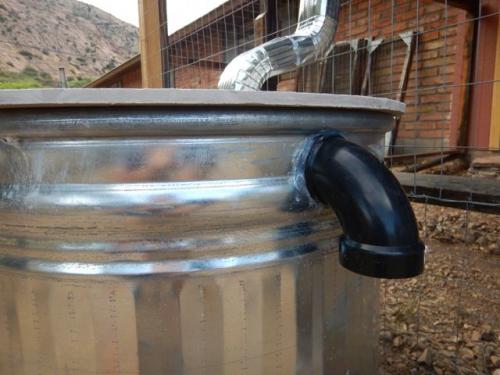
In addition to the factory installed hose bib location, I installed an overflow pipe. I used a BIG drill (a hammer drill for concrete) to cut a 2 1/2" hole just below the top rim. 2" black (ABS) pipe fits through the hole, pipe fittings glued to the pipe inside and outside of the tank hold it in place, and silicone caulk seals up the edges of the hole, where it is a bit oversized for the pipe. That wouldn't matter much for just an overflow pipe, but eventually we will gang more of these tanks together, so that one tank will fill, and then overflow into the next, and so on. I used a 2 1/2" bi-metalic hole saw to cut the hole for the pipe. The diameter of the shank was too big even for the 1/2" chuck of my largest regular drill, so I had to use the super drill. If you don't have (and can't borrow) a drill that big, then smaller hole saws and pipes would work, but you might need multiple pipes (and holes) to match the outflow volume with the inflow. A sabre saw with a metal cutting blade would also work. Keep it neat! ![]()
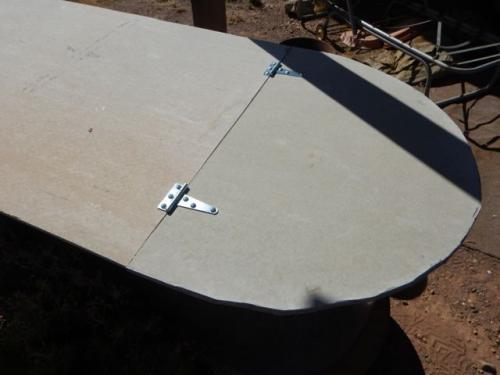
The top was the hardest part. You could use another sheet of plywood, but we knew it would be getting wet most of the time, and went with concrete board...another 4x8 sheet, half inch thick. I think there are saber saw blades capable of cutting this stuff, but I used a 3" masonry blade in a small angle grinder. Use goggles! And ear protection, and keep your body parts out of the plane of the rapidly spinning ceramic disk. They do break, and send pieces flying. I cut the curved ends as a series of short straight cuts...but a little undue side pressure on the disk while trying to cut the curves wrecked a couple of blades. Square ends are still a simple alternative.
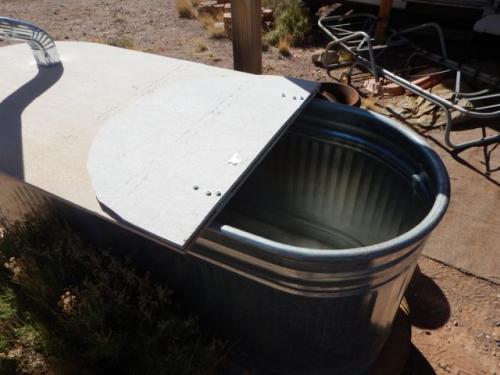
I made an access door at one end of the tank, big enough to dip a bucket into, for my 'long distance watering system' (carrying buckets of water across the property...for now). One straight (keep it straight!) cut, making the door roughly 2 feet square (or D shaped) will work fine. A 1/4" or 3/16" masonry bit in a smaller drill will work great to drill the holes for the bolts to hold the hinges. Screws won't work (for long) on the concrete board. I used #10 sized bolts, washers and nuts on the underside of the board, and 3" T shaped hinges. Make sure your bolts fit through the holes of whatever hinges you find. Again, the edge of the access door must be very straight, and the hinge pins must be aligned with it, and with each other, for this to work well.
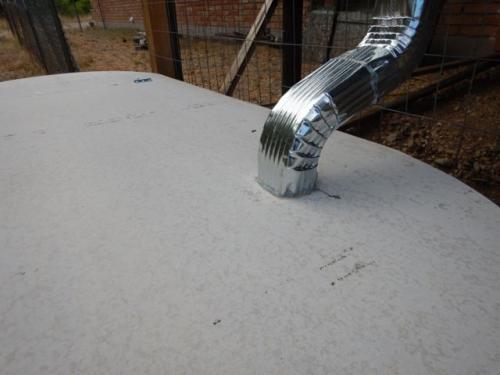
Finally, I cut a hole at the opposite end of the tank lid for the downspout to enter. I traced edge of the bottom of the downspout onto the board, and then used the 1/4" masonry drill bit, and drilled a series of holes around the inside of the line to open up a hole big enough for the downspout. A masonry blade in a sabre saw would connect the dots, and open up the hole, but I just grabbed a nearby drywall saw, and found that it worked better than expected. Hopefully it will still work for drywall board!
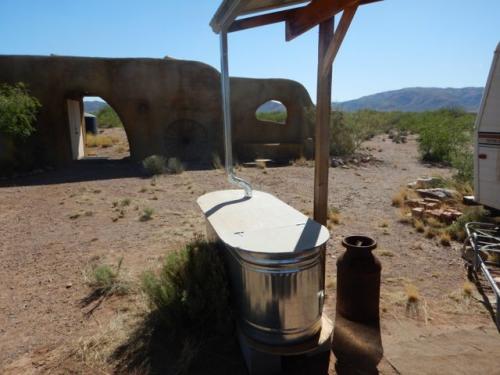
We have various shade structures, with metal roofs (galvanized, corrugated panels), and I installed standard roof gutters to their lower edges, sloping gently toward the end that would get the downspout. There are various gutter systems...all will need not only lengths of gutters, but also the pieces that join them together, pieces to hang them from the roof edge, pieces to join downspouts, and end caps. Screws will likely be a part of that system, and you will want self-tapping screws, to cut their own holes through the metal parts. I used more silicone caulk on the inside of all of the joints, to put the maximum water inside the tank, rather than leaking out of the gutters.


Comments
I am going to go out
and take a few more detail pictures, of the overflow, and the cinderblock base, and such, to add to the essay.
"I’m a human being, first and foremost, and as such I’m for whoever and whatever benefits humanity as a whole.” —Malcolm X
Thought you might like this list for your series.
Link to story and laws by state.
"Religion is what keeps the poor from murdering the rich."--Napoleon
Thanks. Yes,
my brother lives in Colorado, and I was horrified when he told me (a few years ago) about the law, there.
"I’m a human being, first and foremost, and as such I’m for whoever and whatever benefits humanity as a whole.” —Malcolm X
This is brilliant, Bisbo!!! Big TY for this, mate. I know I'm
going to copy it faithfully :=)
TY also for putting in the resilience tag so folks can find it later on in the essay queue. Here's the code for Martha's resilience banner:
I've taken off the code jigger otherwise it posts the image :=) Just add it front and back.
img src="/sites/default/files/user%20images/Resilience1.jpg" width="500" height="249" alt="Resilience1.jpg" /
Your work is so impressive: it's logical, easy-to-follow, and well-finished. You are a craftsman, my friend.
Resilience: practical action to improve things we can control.
3D+: developing language for postmodern spirituality.
Updated with the banner, and a few more pictures.
Thanks for the help, Gerrit.
"I’m a human being, first and foremost, and as such I’m for whoever and whatever benefits humanity as a whole.” —Malcolm X
It sure looks good, Bisbo :=) And TY for the new photos. The
close-ups really show well the details. Man, you are neat and precise!
The great thing about putting it in the Resilience essay queue is that down the road when someone new has a question about the practical how-to's of a rainwater system, we can send them to your essay. You made my day, mate.
Resilience: practical action to improve things we can control.
3D+: developing language for postmodern spirituality.
Like the idea of growing capacity with a group of tanks
The portable set-up should get by most building codes. Thanks for sharing.
Still yourself, deep water can absorb many disturbances with minimal reaction.
--When the opening appears release yourself.
Bisbo, I was thinking that I'd price our nearest feed co-op's
stock tanks when we go there tomorrow to look at some fencing materials. w00t! Ty for the inspiration, mate.
Resilience: practical action to improve things we can control.
3D+: developing language for postmodern spirituality.
Excellent, Bisbo.
Now you've done it. I'll have to finally get off the dime and upload my own catchment essay.
Yours looks great.
I've got a question and a suggestion.
If it's an outlet for a spigot, can you raise the entire tank so you can put a bucket under it and fill the bucket from there?
The suggestion in to put a sock or piece of stocking on the ABS overflow to keep bugs (principally mosquitoes) from infesting the tank.
Well done, mate.
Improve the Resilience Resource Library by adding your links.
Vote Smart - Just the Facts - 40,000 politicians by name or zipcode
The dingus is
the plastic plug I will take out, to put the hose bib (spigot) into, and then run a drip line to some plants. You could easily raise the tank up, say two cinder blocks high, to use it to fill a bucket. I just dip the bucket into the door I made in the top. Your sock suggestion is excellent, and I am going to do that tomorrow.
"I’m a human being, first and foremost, and as such I’m for whoever and whatever benefits humanity as a whole.” —Malcolm X
oh my, it looks dry out there in the desert ...
I wanted to write something about water catchment systems used in Hawaii, but decided to wait til I may be building my own (ha, I am allowed to dream, no?)
Here is an article and a research paper of a lady in Hawaii, who is the goddess of water catchment systems.
Local Hero: Hawaii's Guru of Water Catchment- Trisha Macomber and that's her paper from the University of Hawaii in Manoa
Rainwater Catchment Systems for Hawaii
I know people on Maui, who truck water from the Iao Valley river to their lots up country in Kula. There are plenty of lots still there that have no water meters. Drilling wells is too expensive, and the waiting list to get on municipal water is way over 1000 people. Prices for lots differ over 150,000.00 dollars dependent on them having access to the public water system or not.
But then, when I stop dreaming, I imagine I just can live in a little apartment somewhere as well, doesn't have to be precious paradise islands...
So, yes, water catchment is a real issue to be dealt with.
I like this series, although I never comment and often are very late reading the essays.
https://www.euronews.com/live
It's really dry right now...
our rains should start in July (traditionally the 4th... at 2PM), and then everything greens up.
"I’m a human being, first and foremost, and as such I’m for whoever and whatever benefits humanity as a whole.” —Malcolm X
Added This to the Library for you, Bisbo. n/t
Improve the Resilience Resource Library by adding your links.
Vote Smart - Just the Facts - 40,000 politicians by name or zipcode
Thanks AB
"I’m a human being, first and foremost, and as such I’m for whoever and whatever benefits humanity as a whole.” —Malcolm X
Something I forgot to mention...
Not sure apropos it is for you, Bisbonian, being in the desert, but mosquitoes really like water tanks. No matter what, they seem to find their way in. In lieu of chemicals or tablets, what I've done is pour about a cup of salad oil in the barrel. This film on top of the water keeps the mosquitoes from being able to lay eggs in the water. Plus, it's non-toxic.
Hope this helps if you have bugs that like water out your way.
Improve the Resilience Resource Library by adding your links.
Vote Smart - Just the Facts - 40,000 politicians by name or zipcode
Interesting idea.
We do get mosquitos in town, but not out in the desert, I don't think. I did put the sock on the overflow, so that thould be good, I think.
"I’m a human being, first and foremost, and as such I’m for whoever and whatever benefits humanity as a whole.” —Malcolm X